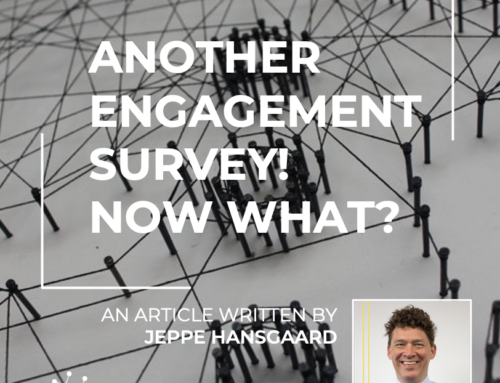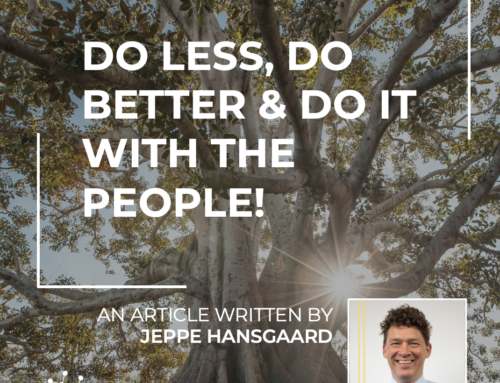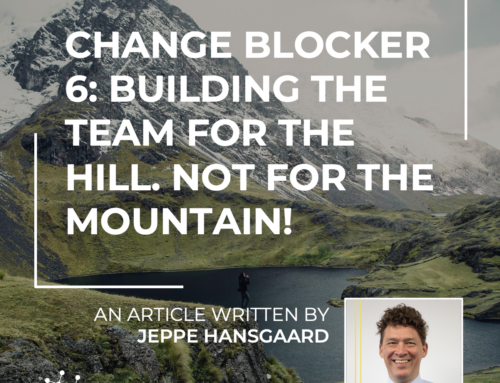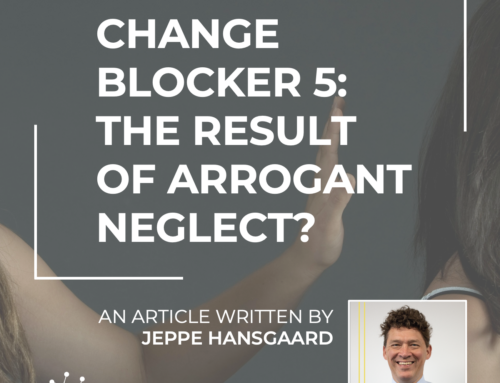FROM OUR CEO
Five Misconceptions About Internal Influencers
February 23rd, 2023 | From our CEO
It is time for an update! In 2018 I published an article called ‘Three Misconceptions About Internal Influencers”. In 2023, it needs an update, as marketeers and consultancies increasingly communicate about internal influencers in a way I need to challenge.
In this article, I will share FIVE misconceptions. I have added two new ones to the original three based on my observations in the last few months.
If you know, the five misconceptions, you can avoid failing with your next change program. Just because you have fallen for fancy lingo and tricks and invested in help from the WRONG consulting company.
What Are the Five Misconceptions?
So what are they five misconceptions?
1. Influencers Are Extrovert. FALSE!
Internal influencers are more introvert than extrovert – not the opposite.
We see that confirmed again and again to the surprise of most executives. How can that be, they ask?
I believe it is simple. If you have a serious question, you would like to make sense of, then where do you go? – To a person that is just waiting for the moment, where you pause a single second, so they can give you their opinion? – Or to a person that is listening, reflecting and then comes back to you with a carefully considered opinion?
Most people would go for the latter.
2. Influencers Are High-Performers. FALSE!
In Innovisor, we see no link between being an internal influencer and being a high-performer. This surprises most executives – not so much non-executives.
What happens, when you are appointed as a high-performer by the management in the organization, is that your colleagues immediately views you in a different way. You are special. Not part of the tribe. You do not conform.
And suddenly you do not receive those lunch invitations and consequently your informal influence drops (Read more in this importan HBR article – Why Super Stars Struggle to Bond with Their Teams)
3. Influencers Are Tenured. FALSE!
The more tenured people are NOT more influential!
The only place where tenure impacts is within what I call tenure bands. Influence on people that have joined the company at the same time.
Why you ask? – When we join a new company, we are open to building new connections. The ones we can easiest build new connections to are other people that are joining the company and who also open to building connections.
The more tenured employees on the contrary already have a network. They have used their brain capacity for connections on other more tenured colleagues. If they should create a relation to you, they would have to replace you with someone from their existing network.
This is rare!
4. Influencers Grasp Complex Communication Material Better. FALSE!
This is a new misconception I have seen recently. Experts claiming that influencers are more capable of grasping dense and complex communication material. Nothing can be further from the truth.
Influencers are people you like and me.
There is absolutely no evidence suggesting that informal influencers are better are reading long articles with high LIX numbers, or more receptive to lengthy presentations of data. What we see is that you – as a change professional – must be just as careful and creative with your messaging to influencers, as you are, when you communicate your change progress to the executive team.
5. I Know Who the Influencers Are in My Organization. FALSE!
In past 15 years I have not met any executive that could name, who the informal influencers in their organization were. We have had quizzes, where they wrote down names on who they thought it was, and then we had done the diagnostic, we compared names.
NOT A SINGLE EXECUTIVE HAS EVER GUESSED THE NAME OF AN INFLUENCER!

What is even worse, is when pseudo-experts apply handheld influencer identification methods – sometimes they call it snowballing – and then claim they can identify influencers. Claiming this is ignoring the analytical complexity of informal networks, and rigor needed for the exercise. Reducing it to a hit & miss exercise. They will deliver you names on a list, but their chances of finding the right influencers are close to 0%. Like finding a needle in a haystack.
It is not worth the investment. You might as well just make a random selection from you employee database.
What is the Learning?
My belief in the power of the people, when it comes to succeeding with change initiatives is INTACT! – and especially, the small group of highly influential employees that have the power to block or ignite. They have never been more important.
The 3% of the employees that drive sense making for 90% of their colleagues – aka #ThreePercentRule. Your people must make sense of the change before they decide to support it. The sense making happens when they talk to the people, they trust the most. People like themselves.
If we challenge and avoid the five misconceptions of influencers, then identification and engagement of influencers should not be optional anymore. You cannot succeed with change without them (Follow #SixChangeBlockers to learn more.)
FROM OUR CEO
Five Misconceptions About Internal Influencers
February 23rd, 2023 | From our CEO
It is time for an update! In 2018 I published an article called ‘Three Misconceptions About Internal Influencers”. In 2023, it needs an update, as marketeers and consultancies increasingly communicate about internal influencers in a way I need to challenge.
In this article, I will share FIVE misconceptions. I have added two new ones to the original three based on my observations in the last few months.
If you know, the five misconceptions, you can avoid failing with your next change program. Just because you have fallen for fancy lingo and tricks and invested in help from the WRONG consulting company.
What Are the Five Misconceptions?
So what are they five misconceptions?
1. Influencers Are Extrovert. FALSE!
Internal influencers are more introvert than extrovert – not the opposite.
We see that confirmed again and again to the surprise of most executives. How can that be, they ask?
I believe it is simple. If you have a serious question, you would like to make sense of, then where do you go? – To a person that is just waiting for the moment, where you pause a single second, so they can give you their opinion? – Or to a person that is listening, reflecting and then comes back to you with a carefully considered opinion?
Most people would go for the latter.
2. Influencers Are High-Performers. FALSE!
In Innovisor, we see no link between being an internal influencer and being a high-performer. This surprises most executives – not so much non-executives.
What happens, when you are appointed as a high-performer by the management in the organization, is that your colleagues immediately views you in a different way. You are special. Not part of the tribe. You do not conform.
And suddenly you do not receive those lunch invitations and consequently your informal influence drops (Read more in this importan HBR article – Why Super Stars Struggle to Bond with Their Teams)
3. Influencers Are Tenured. FALSE!
The more tenured people are NOT more influential!
The only place where tenure impacts is within what I call tenure bands. Influence on people that have joined the company at the same time.
Why you ask? – When we join a new company, we are open to building new connections. The ones we can easiest build new connections to are other people that are joining the company and who also open to building connections.
The more tenured employees on the contrary already have a network. They have used their brain capacity for connections on other more tenured colleagues. If they should create a relation to you, they would have to replace you with someone from their existing network.
This is rare!
4. Influencers Grasp Complex Communication Material Better. FALSE!
This is a new misconception I have seen recently. Experts claiming that influencers are more capable of grasping dense and complex communication material. Nothing can be further from the truth.
Influencers are people you like and me.
There is absolutely no evidence suggesting that informal influencers are better are reading long articles with high LIX numbers, or more receptive to lengthy presentations of data. What we see is that you – as a change professional – must be just as careful and creative with your messaging to influencers, as you are, when you communicate your change progress to the executive team.
5. I Know Who the Influencers Are in My Organization. FALSE!
In past 15 years I have not met any executive that could name, who the informal influencers in their organization were. We have had quizzes, where they wrote down names on who they thought it was, and then we had done the diagnostic, we compared names.
NOT A SINGLE EXECUTIVE HAS EVER GUESSED THE NAME OF AN INFLUENCER!

What is even worse, is when pseudo-experts apply handheld influencer identification methods – sometimes they call it snowballing – and then claim they can identify influencers. Claiming this is ignoring the analytical complexity of informal networks, and rigor needed for the exercise. Reducing it to a hit & miss exercise. They will deliver you names on a list, but their chances of finding the right influencers are close to 0%. Like finding a needle in a haystack.
It is not worth the investment. You might as well just make a random selection from you employee database.
What is the Learning?
My belief in the power of the people, when it comes to succeeding with change initiatives is INTACT! – and especially, the small group of highly influential employees that have the power to block or ignite. They have never been more important.
The 3% of the employees that drive sense making for 90% of their colleagues – aka #ThreePercentRule. Your people must make sense of the change before they decide to support it. The sense making happens when they talk to the people, they trust the most. People like themselves.
If we challenge and avoid the five misconceptions of influencers, then identification and engagement of influencers should not be optional anymore. You cannot succeed with change without them (Follow #SixChangeBlockers to learn more.)
Related articles
Share article
Share article







